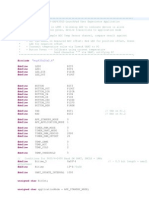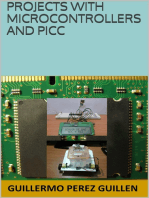arduino-lcd-leds
Uploaded by
joelarduino-lcd-leds
Uploaded by
joel#include <Arduino.
h>
#include <Wire.h>
#include <LiquidCrystal_I2C.h>
// Création de l'objet LCD
LiquidCrystal_I2C lcd(0x27, 16, 2); // Adresse I2C 0x27, 16 colonnes et 2 lignes
// Définition des broches
const int led1 = 9; // LED 300ms
const int led2 = 10; // LED 2s
const int led3 = 11; // LED 5s
const int led4 = 12; // LED contrôlée par bouton (100ms)
const int bouton = 2; // Bouton poussoir
// États des LEDs
volatile bool led1State = false;
volatile bool led2State = false;
volatile bool led3State = false;
volatile bool led4State = false;
volatile bool boutonActif = false;
// Compteurs pour l'affichage LCD
volatile unsigned long lastLCDUpdate = 0;
const unsigned long LCD_UPDATE_INTERVAL = 500; // Mise à jour LCD toutes les 500ms
void setup() {
// Initialisation du LCD
lcd.init();
lcd.backlight();
lcd.clear();
// Message initial
lcd.setCursor(0, 0);
lcd.print("Etat des LEDs:");
// Configuration des broches
pinMode(led1, OUTPUT);
pinMode(led2, OUTPUT);
pinMode(led3, OUTPUT);
pinMode(led4, OUTPUT);
pinMode(bouton, INPUT_PULLUP);
digitalWrite(led1, LOW);
digitalWrite(led2, LOW);
digitalWrite(led3, LOW);
digitalWrite(led4, LOW);
// Désactiver les interruptions pendant la configuration
noInterrupts();
// Configuration du Timer1 pour LED1 (300ms)
TCCR1A = 0;
TCCR1B = 0;
TCNT1 = 0;
OCR1A = 4687;
TCCR1B |= (1 << WGM12);
TCCR1B |= (1 << CS12) | (1 << CS10);
TIMSK1 |= (1 << OCIE1A);
// Configuration du Timer2 pour LED2 (2s)
TCCR2A = 0;
TCCR2B = 0;
TCNT2 = 0;
OCR2A = 249;
TCCR2A |= (1 << WGM21);
TCCR2B |= (1 << CS22) | (1 << CS21) | (1 << CS20);
TIMSK2 |= (1 << OCIE2A);
// Configuration du Timer0 pour LED3 (5s)
TCCR0A = 0;
TCCR0B = 0;
TCNT0 = 0;
OCR0A = 249;
TCCR0A |= (1 << WGM01);
TCCR0B |= (1 << CS02) | (1 << CS00);
TIMSK0 |= (1 << OCIE0A);
// Configuration de l'interruption du bouton
attachInterrupt(digitalPinToInterrupt(bouton), boutonChange, CHANGE);
// Réactiver les interruptions
interrupts();
}
void updateLCD() {
lcd.setCursor(0, 1);
// Affiche l'état de chaque LED (● pour allumée, ○ pour éteinte)
lcd.print(led1State ? "1:" : "1:");
lcd.print(led1State ? "\x01" : "\x00");
lcd.print(" ");
lcd.print(led2State ? "2:" : "2:");
lcd.print(led2State ? "\x01" : "\x00");
lcd.print(" ");
lcd.print(led3State ? "3:" : "3:");
lcd.print(led3State ? "\x01" : "\x00");
lcd.print(" ");
lcd.print(led4State ? "4:" : "4:");
lcd.print(led4State ? "\x01" : "\x00");
}
void loop() {
// Mise à jour périodique du LCD
if (millis() - lastLCDUpdate >= LCD_UPDATE_INTERVAL) {
updateLCD();
lastLCDUpdate = millis();
}
if (!boutonActif) {
digitalWrite(led4, LOW);
led4State = false;
}
}
// Interruption Timer1 pour LED1 (300ms)
ISR(TIMER1_COMPA_vect) {
led1State = !led1State;
digitalWrite(led1, led1State);
}
// Interruption Timer2 pour LED2 (2s)
volatile uint16_t timer2Count = 0;
ISR(TIMER2_COMPA_vect) {
timer2Count++;
if(timer2Count >= 122) {
led2State = !led2State;
digitalWrite(led2, led2State);
timer2Count = 0;
}
}
// Interruption Timer0 pour LED3 (5s)
volatile uint16_t timer0Count = 0;
ISR(TIMER0_COMPA_vect) {
timer0Count++;
if(timer0Count >= 305) {
led3State = !led3State;
digitalWrite(led3, led3State);
timer0Count = 0;
}
}
// Interruption pour LED4 (100ms) - Utilise Timer2
volatile uint16_t led4Counter = 0;
ISR(TIMER2_COMPA_vect) {
if (boutonActif) {
led4Counter++;
if (led4Counter >= 6) {
led4State = !led4State;
digitalWrite(led4, led4State);
led4Counter = 0;
}
}
}
// Interruption du bouton
void boutonChange() {
boutonActif = (digitalRead(bouton) == LOW);
if (!boutonActif) {
digitalWrite(led4, LOW);
}
}
You might also like
- Creating A Raspberry Pi-Based Beowulf Cluster: Joshua KiepertNo ratings yetCreating A Raspberry Pi-Based Beowulf Cluster: Joshua Kiepert15 pages
- ATMega16 AVR Microcontroller LCD Digital Clock100% (2)ATMega16 AVR Microcontroller LCD Digital Clock5 pages
- ATMega16 Microcontroller Digital LM35 LCD Thermometer100% (3)ATMega16 Microcontroller Digital LM35 LCD Thermometer4 pages
- PID Control MAX6675 Thermocouple Arduino Schematic With Rotary Encoder100% (1)PID Control MAX6675 Thermocouple Arduino Schematic With Rotary Encoder13 pages
- Real Time Clock With Alarm Option Using AT89S52 and DS1307 ICNo ratings yetReal Time Clock With Alarm Option Using AT89S52 and DS1307 IC13 pages
- Thank You Letter Doc in Black and White Simple Elegant Style - 20241024 - 230623 - 0000No ratings yetThank You Letter Doc in Black and White Simple Elegant Style - 20241024 - 230623 - 00006 pages
- Aim of Experiment: Write A Program To Read Temperature From Sensor (LM35) and Display It in LCDNo ratings yetAim of Experiment: Write A Program To Read Temperature From Sensor (LM35) and Display It in LCD8 pages
- Soalan PRA MySkills 2013 - Release PublisNo ratings yetSoalan PRA MySkills 2013 - Release Publis11 pages
- Ccs-Picc - HTML: // LCD Module ConnectionsNo ratings yetCcs-Picc - HTML: // LCD Module Connections5 pages
- PIC18F4550 Watchdog Timer - PIC Controllers100% (2)PIC18F4550 Watchdog Timer - PIC Controllers5 pages
- "msp430x20x2.h": // TXD On P1.1 // RXD On P1.2No ratings yet"msp430x20x2.h": // TXD On P1.1 // RXD On P1.26 pages
- Netapp Ontap Select On Ibm Solution Architecture: CloudNo ratings yetNetapp Ontap Select On Ibm Solution Architecture: Cloud12 pages
- Basic Parts of Computer and Its FunctionsNo ratings yetBasic Parts of Computer and Its Functions17 pages
- (Ebook) Embedded System Design by Frank Vahid; Tony Givargis ISBN 9789971514051, 9971514052 - The latest ebook is available, download it today100% (1)(Ebook) Embedded System Design by Frank Vahid; Tony Givargis ISBN 9789971514051, 9971514052 - The latest ebook is available, download it today55 pages
- Benjamin Alfred S. Ramirez - Q1 - TVL-ICT-CSS1-Week5-1stSemNo ratings yetBenjamin Alfred S. Ramirez - Q1 - TVL-ICT-CSS1-Week5-1stSem4 pages
- Lecture 2 - Types of Multimedia and ConceptsNo ratings yetLecture 2 - Types of Multimedia and Concepts36 pages
- Manual de Instruções NEC M260XS (155 Páginas)No ratings yetManual de Instruções NEC M260XS (155 Páginas)2 pages
- Case Study of RTOS and Embedded DevicesNo ratings yetCase Study of RTOS and Embedded Devices29 pages
- Parallel Processing Chapter - 2: Basics of Architectural DesignNo ratings yetParallel Processing Chapter - 2: Basics of Architectural Design29 pages

























































































